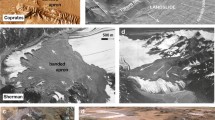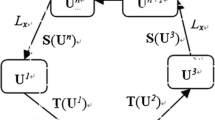Abstract
Surprisingly, hypermobility (high velocity and long run-out) is a remarkable feature of large landslides and is still poorly understood. In this paper, a velocity-weakening friction law is incorporated into a depth-averaged landslide model for explaining the higher mobility mechanism of landslides. In order to improve the precision of the calculation, a coupled numerical method based on the finite volume method is proposed to solve the model equations. Finally, several numerical tests are performed to verify the stability of the algorithm and reliability of the model. The comparison between numerical results and experimental data indicates that the presented model can predict the movement of landslide accurately. Considering the effect of velocity-weakening friction law, the presented model can better reflect the hypermobility of landslide than the conventional Mohr–Coulomb friction model. This work shows that the application of a universal velocity-weakening friction law is effective in describing the hypermobility of landslide and predicting the extent of landslides.






Similar content being viewed by others
References
Beeler NM, Tullis TE, Goldsby DL (2008) Constitutive relationships and physical basis of fault strength due to flash heating. J Geophys Res 113:B01401
Benkhaldoun F, Sari S, Seaid M (2012) A flux-limiter method for dam-break flows over erodible sediment beds. Appl Math Model 36(10):4847–4861
Brufau P, García-Navarro P, Vázquez-Cendón ME (2004) Zero mass error using unsteady wetting–drying conditions in shallow flows over dry irregular topography. Int J Numer Methods Fluids 45(10):1047–1082
Cagnoli B, Romano GP (2010) Pressures at the base of dry flows of angular rock fragments as a function of grain size and flow volume: Experimental results. J Volcanol Geotherm Res 196(3):236–244
Davies TR, McSaveney MJ (1999) Run-out of dry granular avalanches. Can Geotech J 36(2):313–320
Davies TR, McSaveney MJ, Kelfoun K (2010) Runout of the Socompa volcanic debris avalanche, Chile: a mechanical explanation for low basal shear resistance. Bull Volcanol 72(8):933–944
De Blasio FV (2011) Landslides in Valles Marineris (Mars): a possible role of basal lubrication by sub-surface ice. Planet Space Sci 59(13):1384–1392
Dong JJ, Lee WR, Lin ML, Huang AB, Lee YL (2009) Effects of seismic anisotropy and geological characteristics on the kinematics of the neighboring Jiufengershan and Hungtsaiping landslides during Chi-Chi earthquake. Tectonophysics 466:438–457
Dong JJ, Yang CM, Yu WL, Lee CT, Miyamoto Y, Shimamoto T (2013) Velocity displacement dependent friction coefficient and the kinematics of gaint landslide. In: Ugai K, Yagi H, Wakai A (eds) Earthquake-induced landslides. Springer, pp 395–401
Ezzat MF, Mourad MA, Yousef MM (2014) Experimental investigation of static friction coefficient between vehicle tyre and various road conditions. Int J Veh Struct Syst 6(1/2):1
Fei M, Sun Q, Zhong D, Zhou GG (2012) Simulations of granular flow along an inclined plane using the Savage–Hutter model. Particuology 10:236–241
Ferri F, Toro GD, Hirose T, Shimamoto T (2010) Evidence of thermal pressurization in high-velocity friction experiments on smectite-rich gouges. Terra Nov. 22(5):347–353
Fritz HM, Hager WH, Minor HE (2003) Landslide generated impulse waves. 2. Hydrodynamic impact craters. Exp Fluids 35(6):520–532
Gerolymos N, Gazetas G (2007) A model for grain-crushing-induced landslides—Application to Nikawa, Kobe 1995. Soil Dyn Earthq Eng 27(9):803–817
Goren L, Aharonov E (2007) Long runout landslides: the role of frictional heating and hydraulic diffusivity. Geophys Res Lett 34(7)
Goren L, Aharonov E (2009) On the stability of landslides: a thermo-poro-elastic approach. Earth Planet Sci Lett 277(3):365–372
Gray JMNT, Wieland M, Hutter K (1999) Gravity-driven free surface flow of granular avalanches over complex basal topography. Proc R Soc Lond Ser A Math Phys Eng Sci 455(1985):1841–1874
Heller V, Hager WH (2011) Wave types of landslide generated impulse waves. Ocean Eng 38(4):630–640
Hutter K, Luca I (2012) Two-layer debris mixture flows on arbitrary terrain with mass exchange at the base and the interface. Contin Mech Thermodyn 24(4–6):525–558
Iverson RM (1997) The physics of debris flows. Rev Geophys 35(3):245–296
Iverson RM (2012) Elementary theory of bed-sediment entrainment by debris flows and avalanches. J Geophys Res 117:F03006
Iverson RM, Logan M, LaHusen RG, Berti M (2010) The perfect debris flow aggregated results from 28 large-scale experiments. J Geophys Res 115:F03005
Jop P, Forterre Y, Pouliquen O (2006) A constitutive law for dense granular flows. Nature 441:727–730
Kogut L, Etsion I (2004) A static friction model for elastic–plastic contacting rough surfaces. J Tribol 126(1):34–40
Lê L, Pitman EB (2009) A model for granular flows over an erodible surface. Siam J Appl Math 70(5):1407–1427
Legros F (2002) The mobility of long-runout landslides. Eng Geol 63(3):301–331
Liang D, Falconer RA, Lin B (2006) Comparison between TVD-MacCormack and ADI-type solvers of the shallow water equations. Adv Water Resour 29(12):1833–1845
Lucas A, Mangeney A (2007) Mobility and topographic effects for large Valles Marineris landslides on Mars. Geophys Res Lett 34:L10201. doi:10.1029/2007GL029835
Lucas A, Mangeney A, Ampuero JP (2014) Frictional velocity-weakening in landslides on Earth and on other planetary bodies. Nat Commun 5
Mangeney A, Tsimring LS, Volfson D, Aranson IS, Bouchut F (2007) Avalanche mobility induced by the presence of an erodible bed and associated entrainment. Geophys Res Lett 34:L22401. doi:10.1029/2007GL031348
Massaro E, Martelloni G, Bagnoli F (2011) Particle based method for shallow landslides: modeling sliding surface lubrication by rainfall. CMSIM Int J Nonlinear Sci 147–158
McDougall S, Hungr O (2005) Dynamic modelling of entrainment in rapid landslides. Can Geotech J 42(5):1437–1448
Miyamoto Y, Shimamoto T, Togo T, Dong JJ, Lee CT (2009) Dynamic weakening of bedding-parallel fault gouge as a possible mechanism for catastrophic Tsaoling landslide induced by 1999 Chi–Chi earthquake. The next generation of research on earthquake-induced landslides: an international conference in commemoration of 10th anniversary of the Chi-Chi Earthquake 398–401
Mizoguchi K, Hirose T, Shimamoto T, Fukuyama E (2007) Reconstruction of seismic faulting by high-velocity friction experiments: an example of the 1995 Kobe earthquake. Geophys Res Lett 34:L01308. doi:10.1029/2006GL027931
Ochiai H, Okada Y, Furuya G, Okura Y, Matsui T, Sammori T, Sassa K (2004) A fluidized landslide on a natural slope by artificial rainfall. Landslides 1(3):211–219
Okura Y, Kitahara H, Ochiai H, Sammori T, Kawanami A (2002) Landslide fluidization process by flume experiments. Eng Geol 66(1):65–78
Ouyang C, He S, Xu Q, Luo Y, Zhang W (2013) A MacCormack-TVD finite difference method to simulate the mass flow in mountainous terrain with variable computational domain. Comput Geosci 52:1–10
Pitman E, Nichita C, Patra A, Bauer A, Bursik M, Weber A (2003) A model of granular flows over an erodible surface. Discret Contin Dyn Syst Ser B 3:589–600
Rice JR (2006) Heating and weakening of faults during earthquake slip. J Geophys Res Solid Earth (1978–2012) 111(B5)
Sosio R, Crosta GB, Chen JH, Hungr O (2012) Modelling rock avalanche propagation onto glaciers. Quat Sci Rev 47:23–40
Stoker JJ (1957) Water waves. Interscience, New York
Tayebi N, Polycarpou AA (2004) Modeling the effect of skewness and kurtosis on the static friction coefficient of rough surfaces. Tribol Int 37(6):491–505
Togo T, Ma SL, Hirose T (2009) High-velocity friction of faults: a review and implication for landslide studies. The next generation of research on earth-quake-induced landslides: an international conference in commemoration of 10th anniversary of the Chi-Chi Earthquake 205–21
Van Leer B (1979) Towards the ultimate conservative difference scheme. V. A second-order sequel to Godunov’s method. J Comput Phys 32(1):101–136
Vardoulakis I (2000) Catastrophic landslides due to frictional heating of the failure plane. Mech Cohesive Frictional Mater 5(6):443–467
Wang G (2011) Formation of large scale landslide dams and failure prediction. Proceedings of 2011 Landslide Symposium, Kansai Branch of Japan Landslide Society, pp 65–80 (in Japanese)
Wang G, Huang R, Kamai T, Zhang F (2013) The internal structure of a rockslide dam induced by the 2008 Wenchuan (Mw 7.9) earthquake, China. Eng Geol 156:28–36
Xing AG, Wang G, Yin YP, Jiang Y, Wang GZ, Yang SY, Dai JA (2014) Dynamic analysis and field investigation of a fluidized landslide in Guanling, Guizhou, China. Eng Geol 181:1–14
Yang CM, Yu WL, Dong JJ, Kuo CY, Shimamoto T, Lee CT, Miyamoto Y (2014) Initiation, movement, and run-out of the giant Tsaoling landslide—What can we learn from a simple rigid block model and a velocity–displacement dependent friction law? Eng Geol 182:158–181
Yano K, Shimamoto T, Oohashi K, Dong JJ, Lee CT (2009) Ultra-low friction of shale and clayey fault gouge at high velocities: implication for Jiufengershan landslide induced by 1999 Chi-Chi earthquake. The next generation of research on earthquake induced landslides: an international conference in commemoration of 10th anniversary of the Chi-Chi Earthquake 402–406
Zoppou C, Roberts S (2000) Numerical solution of the two-dimensional unsteady dam break. Appl Math Model 24(7):457–475
Acknowledgments
The authors thank two anonymous reviewers for helpful suggestions. Financial support from the National Key Basic Research Program of China (2013CB733201) and NSFC (Grant No. 41272346, 41472293, and 41101008) is acknowledged.
Author information
Authors and Affiliations
Corresponding author
Rights and permissions
About this article
Cite this article
Liu, W., He, S., Li, X. et al. Two-dimensional landslide dynamic simulation based on a velocity-weakening friction law. Landslides 13, 957–965 (2016). https://doi.org/10.1007/s10346-015-0632-z
Received:
Accepted:
Published:
Issue Date:
DOI: https://doi.org/10.1007/s10346-015-0632-z




